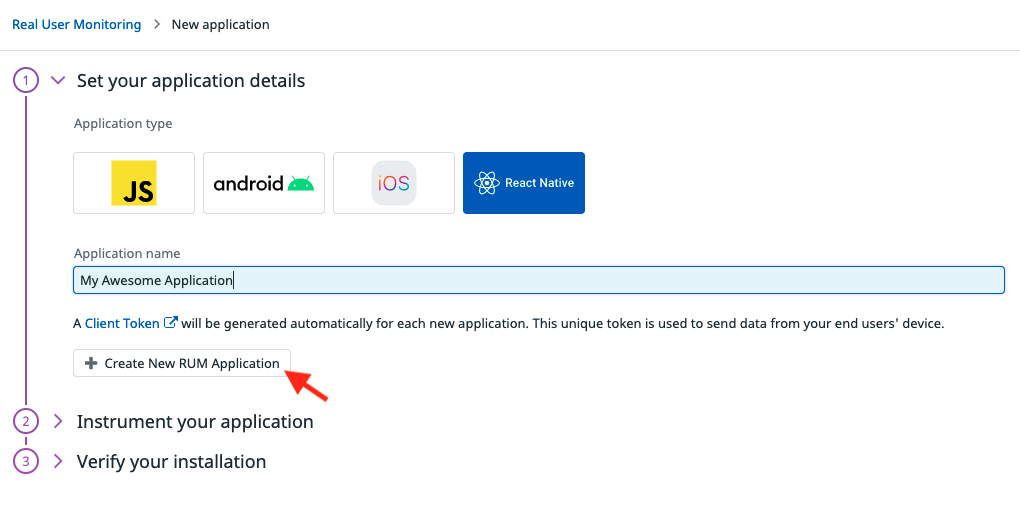Datadog Real User Monitoring (RUM) enables you to visualize and analyze the real-time performance and user journeys of your application’s individual users.
To install with NPM, run:
npm install @datadog/mobile-react-nativeTo install with Yarn, run:
yarn add @datadog/mobile-react-nativeMinimum React Native version: SDK supports React Native version 0.63.4 or higher. Compatibility with older versions is not guaranteed out of the box.
Versions 1.0.0-rc5 and higher require you to have compileSdkVersion = 31 in the Android application setup, which implies that you should use Build Tools version 31, Android Gradle Plugin version 7, and Gradle version 7 or higher. To modify the versions, change the values in the buildscript.ext block of your application's top-level build.gradle file. Datadog recommends using React Native version 0.67 or higher.
- In the Datadog app, select UX Monitoring > RUM Applications > New Application.
- Choose
react-nativeas your Application Type. - Provide a new application name to generate a unique Datadog application ID and client token.
To ensure the safety of your data, you must use a client token. You cannot use only Datadog API keys to configure the @datadog/mobile-react-native library, because they would be exposed client-side. For more information about setting up a client token, see the Client Token documentation.
import {
DatadogProvider,
DatadogProviderConfiguration
} from '@datadog/mobile-react-native';
const datadogConfiguration = new DatadogProviderConfiguration(
'<CLIENT_TOKEN>',
'<ENVIRONMENT_NAME>',
'<RUM_APPLICATION_ID>',
true, // track User interactions (e.g.: Tap on buttons. You can use 'accessibilityLabel' element property to give tap action the name, otherwise element type will be reported)
true, // track XHR Resources
true // track Errors
);
// Optional: Select your Datadog website (one of "US1", "US3", "US5", EU1", or "US1_FED"). Default is "US1".
datadogConfiguration.site = 'US1';
// Optional: enable or disable native crash reports
datadogConfiguration.nativeCrashReportEnabled = true;
// Optional: sample RUM sessions (here, 80% of session will be sent to Datadog. Default = 100%)
datadogConfiguration.sessionSamplingRate = 80;
// Optional: sample tracing integrations for network calls between your app and your backend (here, 80% of calls to your instrumented backend will be linked from the RUM view to the APM view. Default = 20%)
// You need to specify the hosts of your backends to enable tracing with these backends
datadogConfiguration.resourceTracingSamplingRate = 80;
datadogConfiguration.firstPartyHosts = ['example.com']; // matches 'example.com' and subdomains like 'api.example.com'
// Optional: set the reported service name (by default, it'll use the package name / bundleIdentifier of your Android / iOS app respectively)
datadogConfiguration.serviceName = 'com.example.reactnative';
// Optional: let the SDK print internal logs (above or equal to the provided level. Default = undefined (meaning no logs))
datadogConfiguration.verbosity = SdkVerbosity.WARN;
export default function App() {
return (
<DatadogProvider configuration={datadogConfiguration}>
<Navigation />
</DatadogProvider>
);
}Because React Native offers a wide range of libraries to create screen navigation, by default only manual View tracking is supported. You can manually start and stop a View using the following startView() and stopView methods.
import {
DdSdkReactNative,
DdSdkReactNativeConfiguration,
DdLogs,
DdRum
} from '@datadog/mobile-react-native';
// Start a view with a unique view identifier, a custom view url, and an object to attach additional attributes to the view
DdRum.startView('ViewKey', 'ViewName', Date.now(), {
'custom.foo': 'something'
});
// Stops a previously started view with the same unique view identifier, and an object to attach additional attributes to the view
DdRum.stopView('ViewKey', Date.now(), { 'custom.bar': 42 });Before data is uploaded to Datadog, it is stored in cleartext in your application's cache directory. This cache folder is protected by Android's Application Sandbox, meaning that on most devices this data can't be read by other applications. However, if the mobile device is rooted, or someone tempers with the linux kernel, the stored data might become readable.
Before data is uploaded to Datadog, it is stored in cleartext in the cache directory (Library/Caches)
of your application sandbox, which can't be read by any other app installed on the device.

